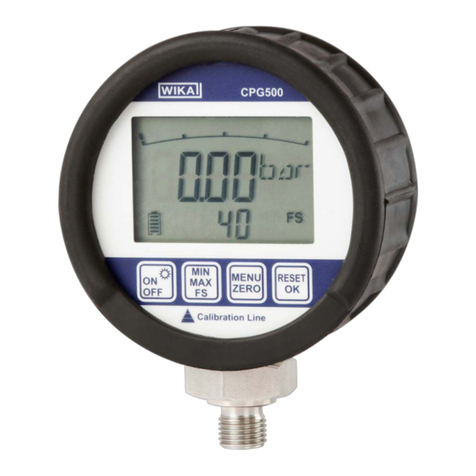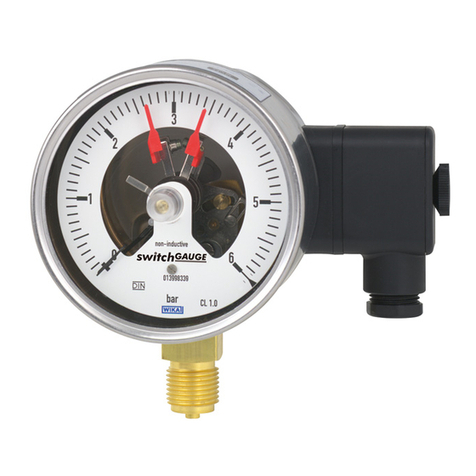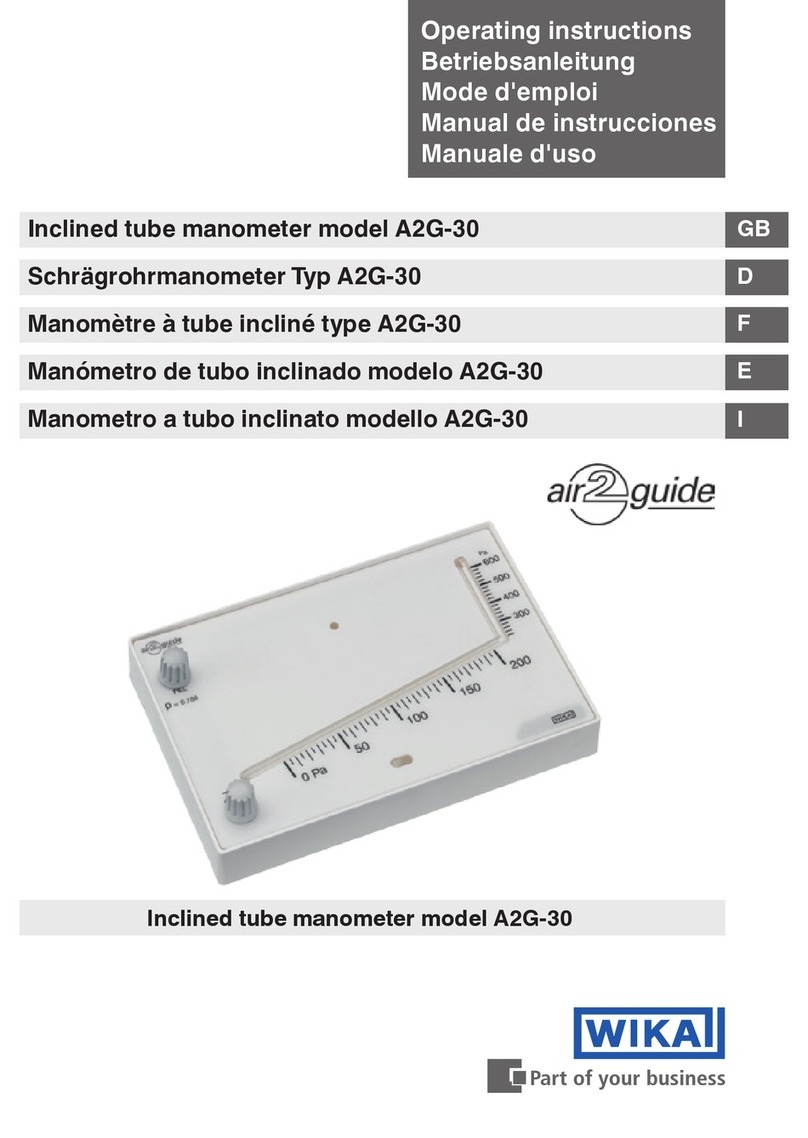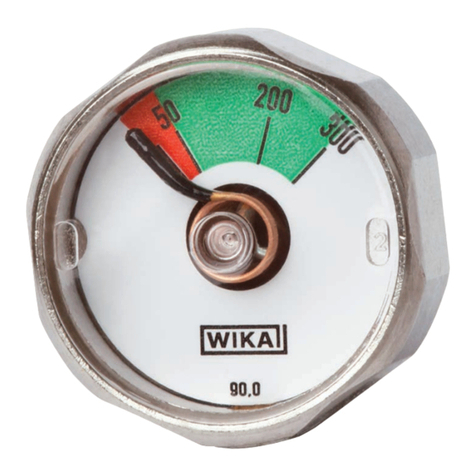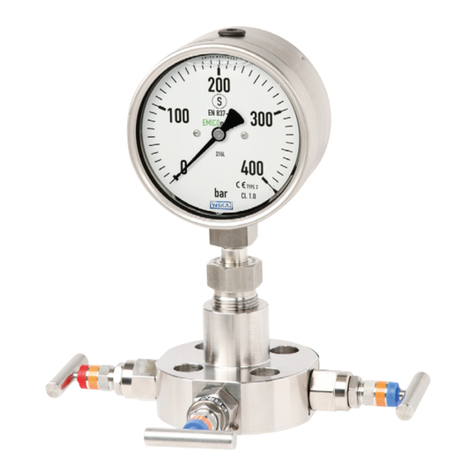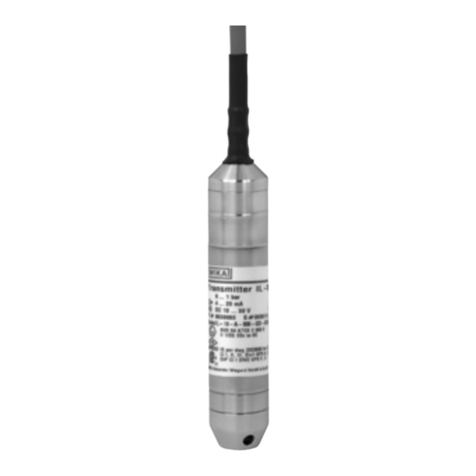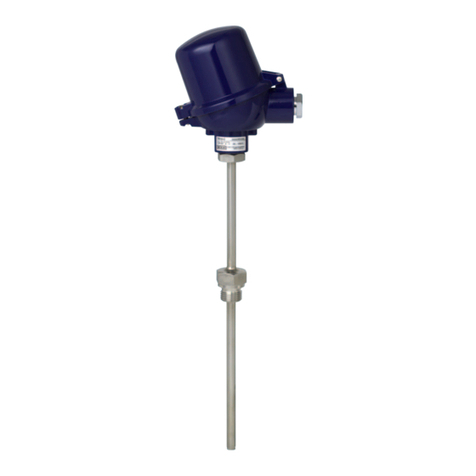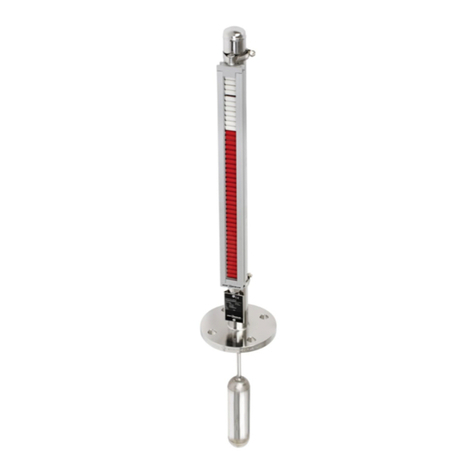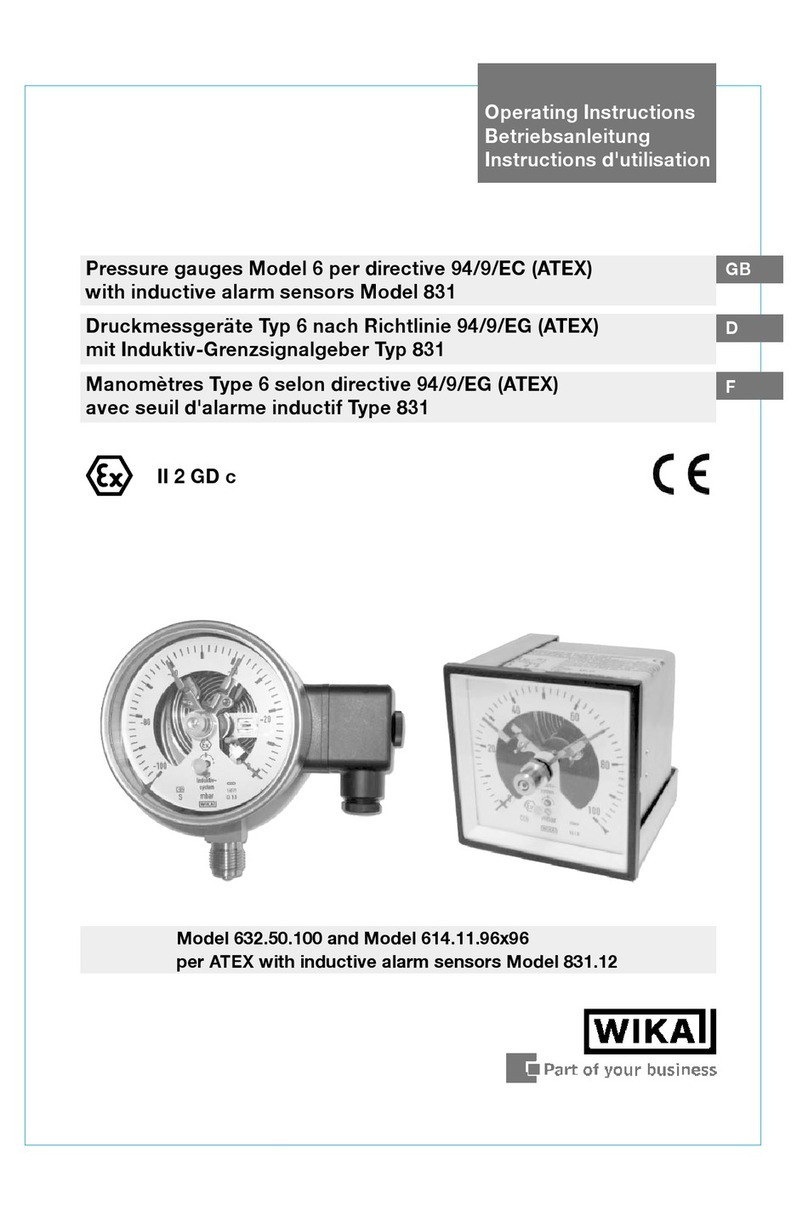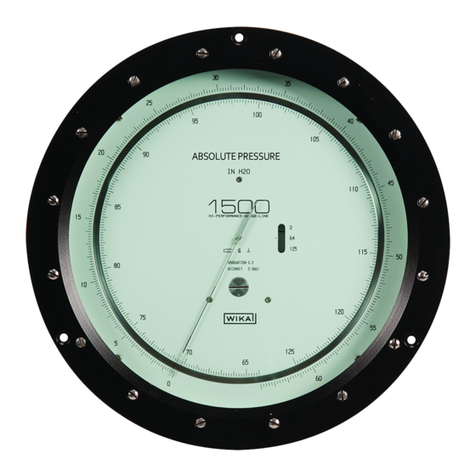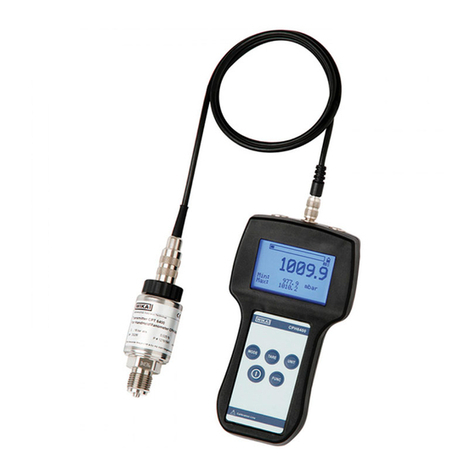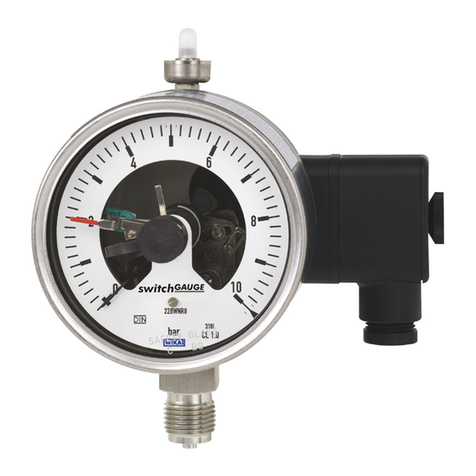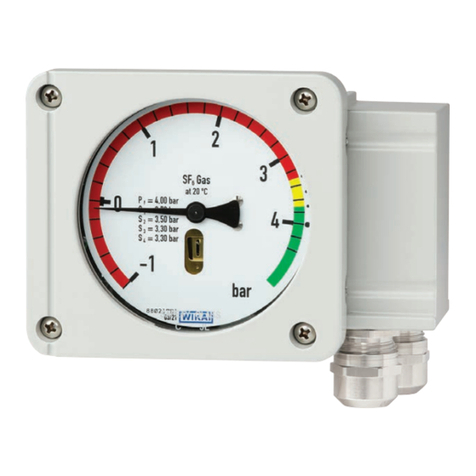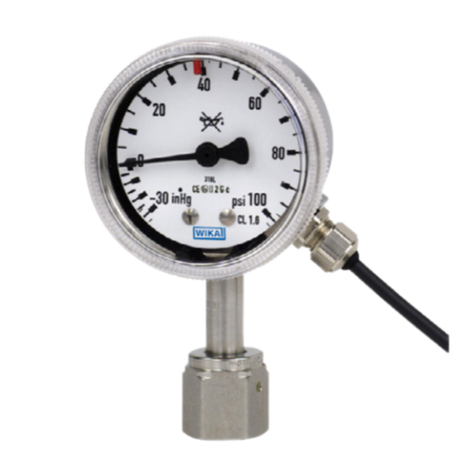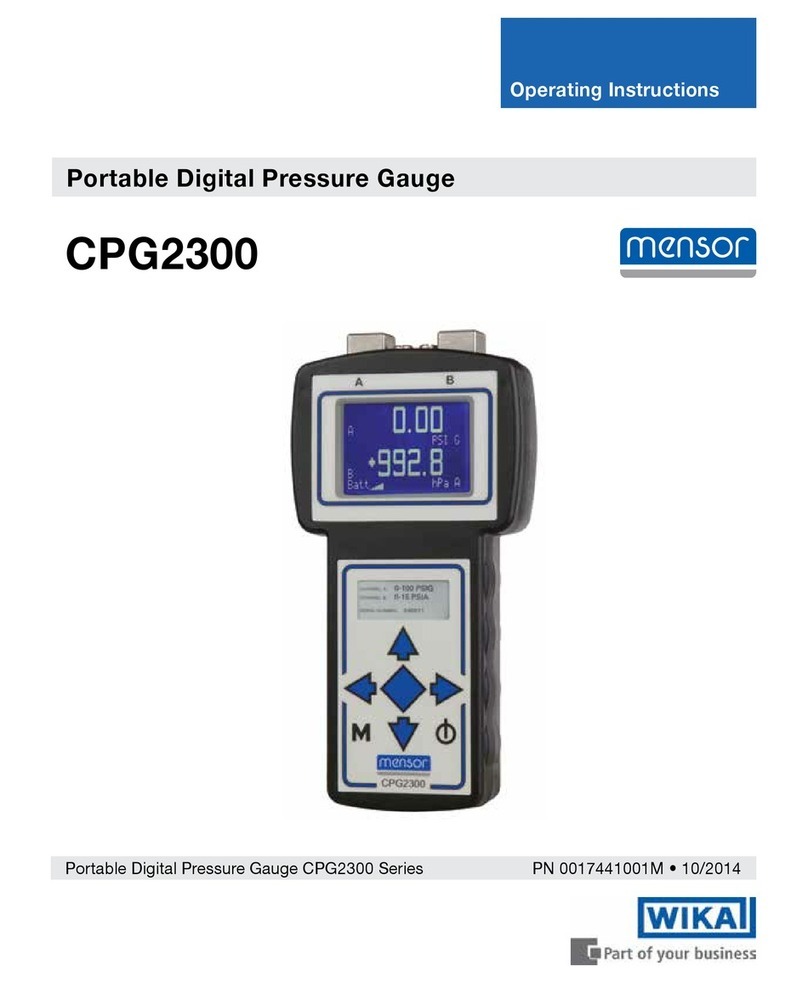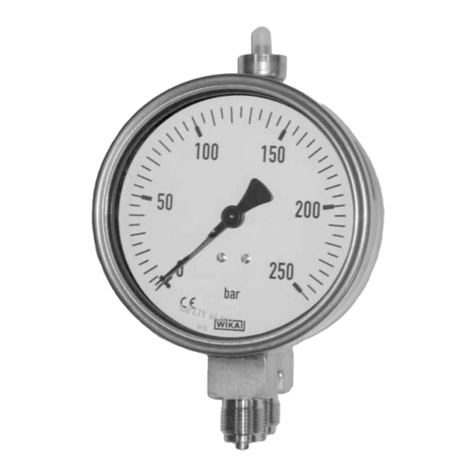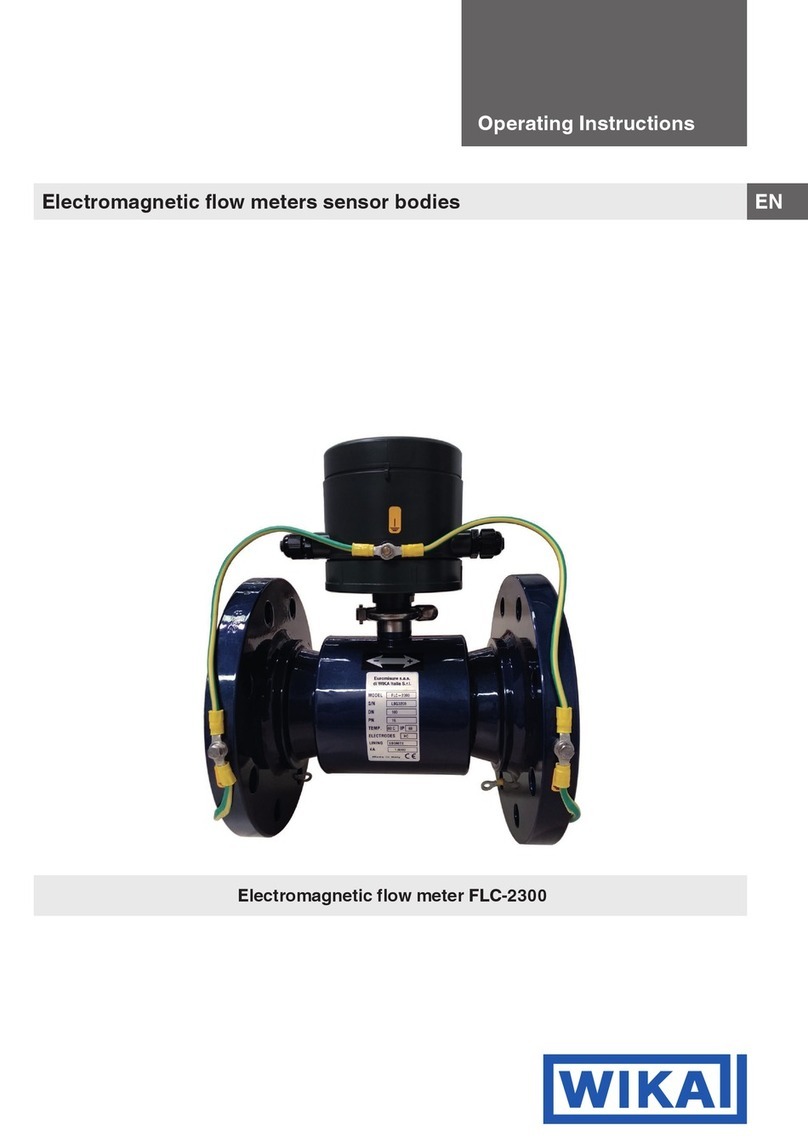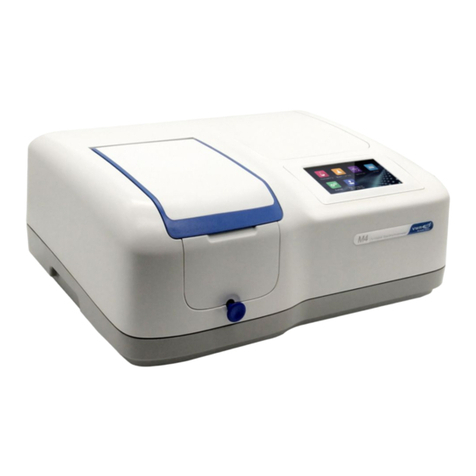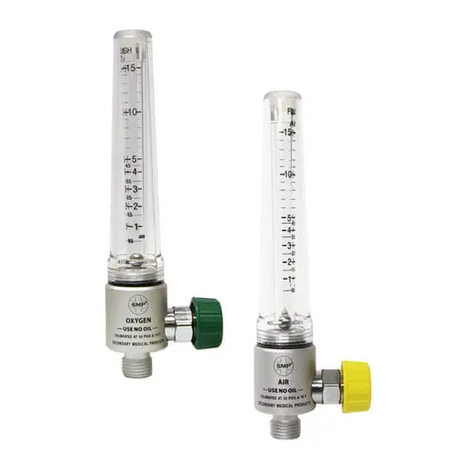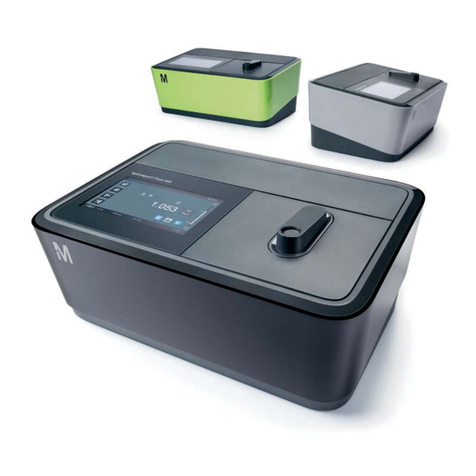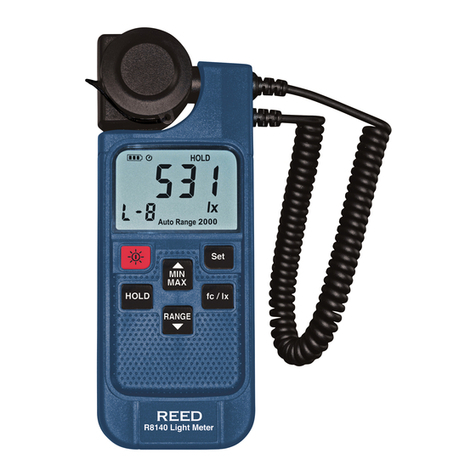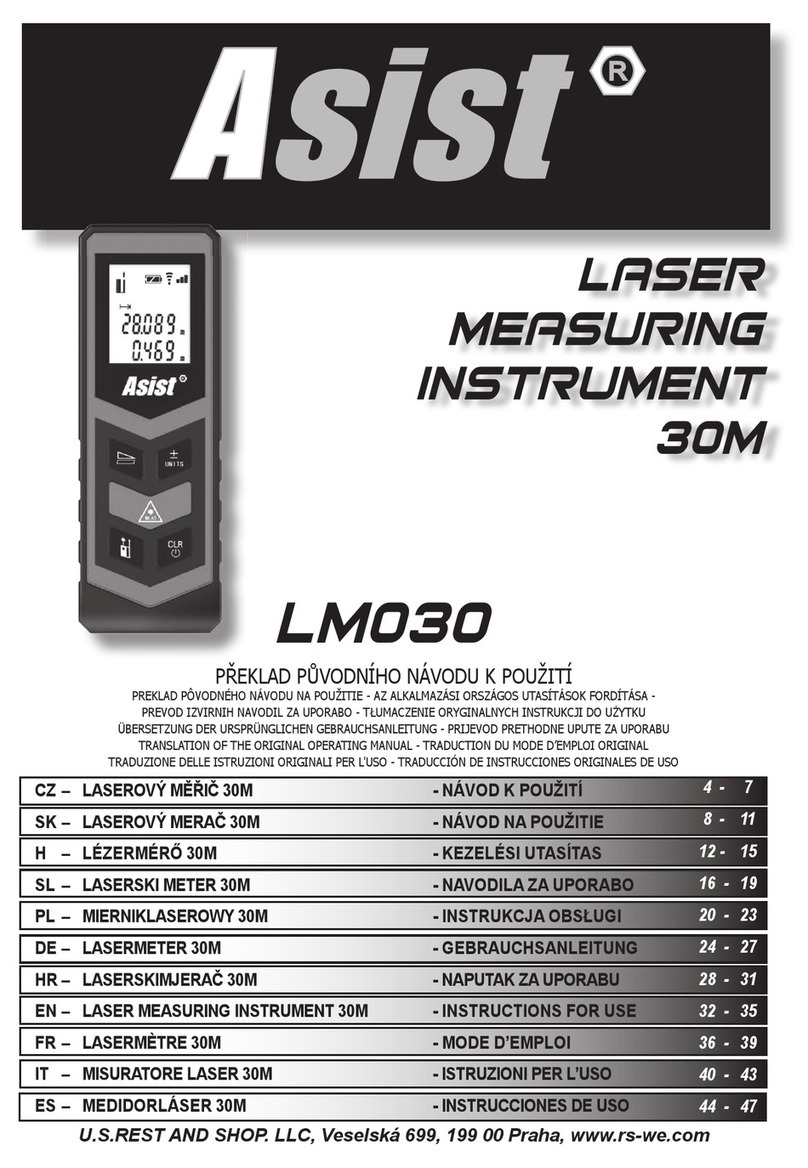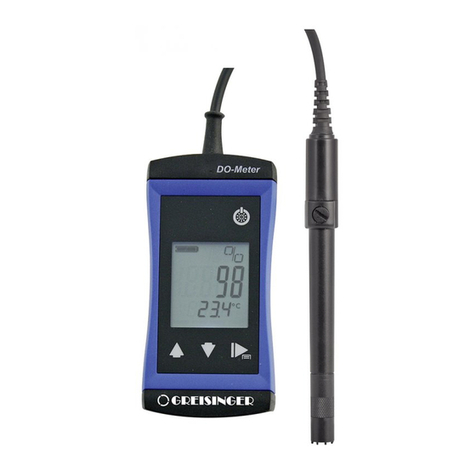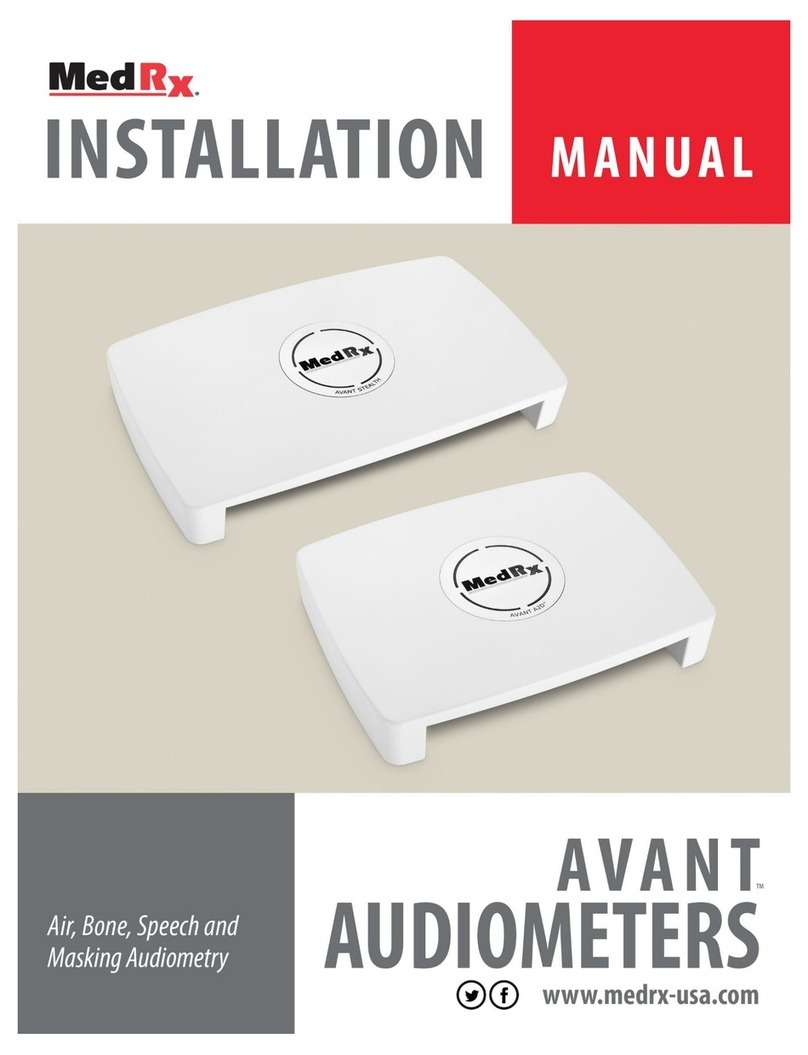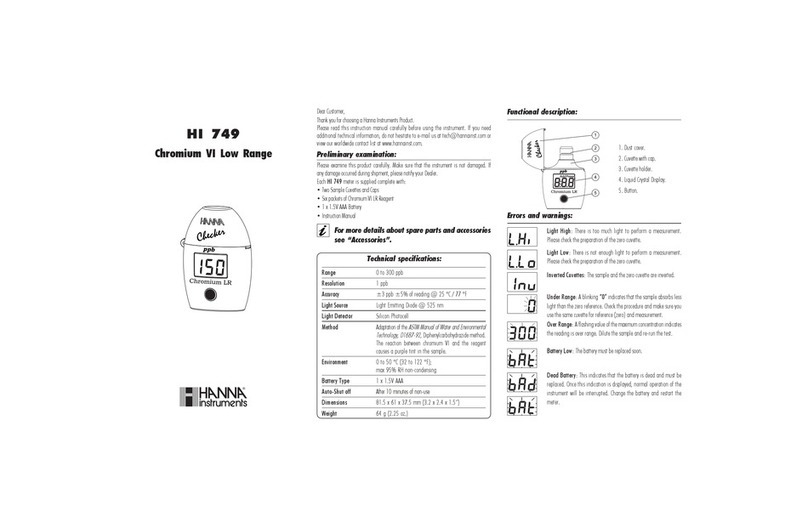WIKA GDM-63 User manual

Operating instructions
Betriebsanleitung
EN
DE
Gasdichtewächter, Typ GDM-63
Gas density monitor
Gas density monitor, model GDM-63

2
14502554.01 07/2021 EN/DE
WIKA operating instructions gas density monitor model GDM-63
EN
DE
© 07/2021 WIKA Alexander Wiegand SE & Co. KG
All rights reserved. / Alle Rechte vorbehalten.
WIKA®is a registered trademark in various countries.
WIKA®ist eine geschützte Marke in verschiedenen Ländern.
Prior to starting any work, read the operating instructions!
Keep for later use!
Vor Beginn aller Arbeiten Betriebsanleitung lesen!
Zum späteren Gebrauch aufbewahren!
Betriebsanleitung Typ GDM-63 Seite 23 - 42
Operating instructions model GDM-63 Page 3 - 22

3WIKA operating instructions gas density monitor model GDM-63
EN
14502554.01 07/2021 EN/DE
Contents
1. General information 4
2. Design and function 5
3. Safety 6
4. Transport, packaging and storage 11
5. Commissioning, operation 12
6. Faults 15
7. Maintenance, cleaning and recalibration 16
8. Dismounting, return and disposal 18
9. Specifications 19
10. Accessories 21
Contents

4WIKA operating instructions gas density monitor model GDM-63
EN
14502554.01 07/2021 EN/DE
1. General information
■The instrument described in the operating instructions has been designed and
manufactured using state-of-the-art technology. All components are subject to
stringent quality and environmental criteria during production. Our management
systems are certified to ISO 9001 and ISO 14001.
■These operating instructions contain important information on handling the
instrument. Working safely requires that all safety instructions and work instructions
are observed.
■Observe the relevant local accident prevention regulations and general safety
regulations for the instrument's range of use.
■The operating instructions are part of the product and must be kept in the immediate
vicinity of the instrument and readily accessible to skilled personnel at any time. Pass
the operating instructions on to the next operator or owner of the instrument.
■Skilled personnel must have carefully read and understood the operating instructions
prior to beginning any work.
■The general terms and conditions contained in the sales documentation shall apply.
■Subject to technical modifications.
■Further information:
- Internet address: www.wika.de / www.wika.com
- Relevant data sheets:
SP 60.70 Model GDM-63
SP 61.16 Model GLTC-CV
- Application consultant: Tel.: +49 9372 132-0
Fax: +49 9372 132-406
info@wika.com
1. General information

5WIKA operating instructions gas density monitor model GDM-63
EN
14502554.01 07/2021 EN/DE
2. Design and function
2.1 Overview
Product label
Electrical connection
2.2 Description
Switch contacts
The switch contacts permanently installed in the gas density monitor close or open at
set limit values, depending on the switching function. Switching functions are: Normally
closed, normally open, change-over contact.
The magnetic snap-action contacts are control switches which open or close connected
electric circuits via a contact arm which is moved by the instrument pointer.
Optional recalibration valve
With regard to switchgear safety, asset protection and environmental protection, it is
common to perform functional checks of the measuring instruments on a regular basis.
Article 5 of EU regulation No. 517/2014 on fluorinated greenhouse gases, provides
for checking of the leakage detection system at least every 6 years if it contains
more than 22 kg SF₆ gas and the plant was commissioned after 01 January 2017.
With the help of the optional, permanently welded recalibration valve, the gas density
monitor can be shut off from the process and recalibrated without having to disassemble
it. This not only reduces maintenance time but also minimises the risks of SF₆ gas
emissions and potential leakages during recommissioning.
When connecting a test instrument (e.g. model ACS-10 or model BCS-10) to the
recalibration valve, the gas density monitor is automatically disconnected from the gas
compartment and a recalibration can be performed.The test instrument can then be
disconnected from the recalibration valve and the connection to the gas compartment is
re-established automatically.
The recalibration valve is also available as a retrofit solution for gas density monitors
and other leakage detection systems already installed in the field, as model GLTC-CV,
and can be mounted between the gas compartment and gas density monitor.
2. Design and function

6WIKA operating instructions gas density monitor model GDM-63
EN
14502554.01 07/2021 EN/DE
2.3 Scope of delivery
Cross-check scope of delivery with delivery note.
3. Safety
3.1 Explanation of symbols
WARNING!
... indicates a potentially dangerous situation that can result in serious
injury or death, if not avoided.
CAUTION!
... indicates a potentially dangerous situation that can result in light injuries
or damage to property or the environment, if not avoided.
Information
... points out useful tips, recommendations and information for efficient
and trouble-free operation.
3.2 Intended use
Wherever the gas density of SF₆ gas has to be indicated locally and, at the same time,
circuits need to be switched, the model GDM-63 gas density monitor finds its use.
Gas density monitors are modified contact pressure gauges, specially developed for the
use of SF₆ gas. Temperature influences acting on the enclosed SF₆ gas are compensated
by a compensation system.
The gas density monitors are specially designed for the respective application in switchgear
(pure SF₆ gas, gas mixtures, calibration pressure, switch points ...). Before use, check
whether this instrument is suitable for the intended application.
The insulation values (air gaps and creepage distances) are sized for the following
ambient conditions in accordance with EN 61010-1:2010:
■Altitude up to 2,000 m
■Overvoltage category II
■Pollution degree 2
■Relative humidity: 0 ... 90 % non-condensing (per DIN 40040)
■The strength of the measuring instrument (enclosing non-metal parts) was tested
with a reduced impact energy of 2 J corresponding to IK07 per EN 61010-1:2010.
The IK code is included on the respective product label.
Only use the instrument in applications that lie within its technical performance limits
(e.g. max. ambient temperature, material compatibility, ...).
→ For performance limits see chapter 9 “Specifications”.
2. Design and function / 3. Safety

7WIKA operating instructions gas density monitor model GDM-63
EN
14502554.01 07/2021 EN/DE
This instrument is not permitted to be used in hazardous areas!
The instrument has been designed and built solely for the intended use described here,
and may only be used accordingly.
The technical specifications contained in these operating instructions must be
observed. Improper handling or operation of the instrument outside of its technical
specifications requires the instrument to be taken out of service immediately and
inspected by an authorised WIKA service engineer.
The manufacturer shall not be liable for claims of any type based on operation contrary
to the intended use.
3.3 Improper use
WARNING!
Injuries through improper use
Improper use of the instrument can lead to hazardous situations and
injuries.
▶Refrain from unauthorised modifications to the instrument.
▶Do not use the instrument within hazardous areas.
Any use beyond or different to the intended use is considered as improper use.
3.4 Responsibility of the operator
The instrument is used in the industrial sector. The operator is therefore responsible for
legal obligations regarding safety at work.
The safety instructions within these operating instructions, as well as the safety, accident
prevention and environmental protection regulations for the application area must be
maintained.
The operator is obliged to maintain the product label in a legible condition.
To ensure safe working on the instrument, the operating company must ensure
■that suitable first-aid equipment is available and aid is provided whenever required.
■that the operating personnel are regularly instructed in all topics regarding work safety,
first aid and environmental protection and know the operating instructions and, in
particular, the safety instructions contained therein.
■that the instrument is suitable for the particular application in accordance with its
intended use.
■that personal protective equipment is available.
3. Safety

8WIKA operating instructions gas density monitor model GDM-63
EN
14502554.01 07/2021 EN/DE
3.5 Personnel qualification
WARNING!
Risk of injury should qualification be insufficient
Improper handling can result in considerable injury and damage to
property.
▶The activities described in these operating instructions may only be carried
out by skilled personnel who have the qualifications described below.
Skilled personnel
Skilled personnel, authorised by the operator, are understood to be personnel
who, based on their technical training, knowledge of measurement and control
technology and on their experience and knowledge of country-specific regulations,
current standards and directives, are capable of carrying out the work described and
independently recognising potential hazards.
Specically when using SF₆ gas
The plant operator must ensure that the handling of SF6gas is only carried out by
a qualified company or by qualified persons who have been specially trained in
accordance with IEC 62271-4 or IEC 60480, section 10.3.1.
3.6 Personal protective equipment
The personal protective equipment is designed to protect the skilled personnel from
hazards that could impair their safety or health during work. When carrying out the
various tasks on and with the instrument, the skilled personnel must wear personal
protective equipment.
Follow the instructions displayed in the work area regarding personal protective
equipment!
The requisite personal protective equipment must be provided by the operating
company.
Safety goggles in accordance with EN 166, class 2, mechanical
strength class S
Safety goggles must be worn during the entire period when working on
hoses or gas containers (e.g. gas cylinders, tanks).
The safety goggles protect the eyes from any flying particles, escaping
gas and liquid splashes.
Protective gloves against heat in accordance with EN ISO 13732-1
and against cold in accordance with EN ISO 13732-3
The protective gloves must be worn over the entire period when working
on hoses, gas containers (e.g. gas cylinders, tanks) or components which
heat up to over 60 °C [140 °F].
3. Safety

9WIKA operating instructions gas density monitor model GDM-63
EN
14502554.01 07/2021 EN/DE
3.7 Handling of insulating gases and gas mixtures
SF₆ gas is a greenhouse gas which is listed in the Kyoto Protocol. SF₆ gas must not be
released into the atmosphere, but must be collected in suitable containers.
Properties of insulating gases
■Colourless and odourless
■Chemically neutral
■Inert
■Not flammable
■Heavier than air
■No toxicity
■No damage to the ozone layer
Detailed information is given in IEC 60376 and IEC 61634.
Danger of suocation caused by insulating gases and gas mixtures
High concentrations of gases can lead to asphyxiation, since breathable air is displaced
from the lungs with the inhalation of gas.
Since SF₆ gas is heavier than air, it collects, especially, at ground level or lower-lying
rooms below the reference level (e.g. cellars). This is particularly dangerous since SF6
gas is colourless and odourless and thus may be imperceptible to people.
3.8 Danger caused by decomposition products
Insulating gas in electrical systems may contain decomposition products generated by
electric arcs:
■Gaseous sulphur fluorides
■Sulphur hexafluorides
■Solid and atomized metal fluorides, metal sulphides, metal oxides
■Hydrogen fluoride
■Sulphur dioxide
Decomposition products can be harmful to health.
■They can cause poisoning by inhalation, ingestion or contact with the skin.
■They may be irritating to the eyes, the respiratory system or the skin and burn them.
■Inhalation of large quantities may damage the lungs.
Observe the following safety instructions in order to avoid danger from insulating gas:
■Wear personal protective equipment.
■Read the material safety data sheet of the gas supplier.
■With large leakage, evacuate the area quickly.
■Ensure good ventilation.
■Ensure the leak tightness of the equipment with a leak detector (e.g. model GIR-10).
3. Safety

10 WIKA operating instructions gas density monitor model GDM-63
EN
14502554.01 07/2021 EN/DE
3. Safety
3.9 Applicable standards and directives
Installation, assembly, commissioning:
■BGI 753 (SF₆ plants and equipment in Germany)
■IEC 62271-4 (Handling of SF₆ gas)
■IEC 60376 (New SF₆ gas, technical grade SF₆ gas)
■IEC 60480 (Used SF₆ gas)
■CIGRE report 276, 2005 (Practical SF₆ gas handling instructions)
Leakages during operation:
■IEC 60376 (New SF₆ gas, technical grade SF₆ gas)
■IEC 60480 (Used SF₆ gas)
■CIGRE 2002 (“SF₆ gas in the electrical industry”)
Repair work and maintenance:
■IEC 62271-4 (Use and handling of SF₆ gas in high-voltage switchgear and controlgear)
■CIGRE 1991 (Handling of SF₆ gas)
■CIGRE report 276, 2005 (Practical SF₆ gashandling instructions)
Information
SF6is a colourless and odourless, chemically neutral, inert and
non-ammable gas which is approx. ve times heavier than air, non-toxic
and not harmful to the ozone layer.
Detailed information is given in IEC 60376 and IEC 61634.
3.10 Labelling, safety marks
Product label (example)
Model designation
Model designation of the switch contact
Switching thresholds
Date of manufacture
P# product number
Pin assignment
Schaltzustand bei Skalenanfangswert / Status of switch at minimum scale value
WIKA Alexander Wiegand SE & Co. KG, 63911 Klingenberg

11WIKA operating instructions gas density monitor model GDM-63
EN
14502554.01 07/2021 EN/DE
4. Transport, packaging and storage
4. Transport, packaging and storage
4.1 Transport
Check the instrument for any damage that may have been caused by transport.
Obvious damage must be reported immediately.
CAUTION!
Damage through improper transport
With improper transport, a high level of damage to property can occur.
▶When unloading packed goods upon delivery as well as during
internal transport, proceed carefully and observe the symbols on the
packaging.
▶With internal transport, observe the instructions in chapter 4.2
“Packaging and storage”.
4.2 Packaging and storage
Do not remove packaging until just before mounting.
Keep the packaging as it will provide optimum protection during transport (e.g. change
in installation site, sending for repair).
WARNING!
Physical injuries and damage to property and the environment
caused by hazardous decomposition products
Before storing the instrument, any residual decomposition products must
be removed.
▶For cleaning, see chapter 7.2 “Cleaning”
Permissible conditions at the place of storage:
■Storage temperature: -50 ... +60 °C [-58 ... +140 °F]
■Humidity: ≤ 90 % r. h. (non-condensing)
Avoid exposure to the following factors:
■Soot, vapour, dust and corrosive gases
■Hazardous environments, flammable atmospheres
Store the instrument in its original packaging in a location that fulfils the conditions
listed above. If the original packaging is not available, pack and store the instrument as
described below:
1. Place the instrument, along with the shock-absorbent material, in the packaging.
2. If stored for a prolonged period of time (more than 30 days), place a bag containing
a desiccant inside the packaging.

12 WIKA operating instructions gas density monitor model GDM-63
EN
14502554.01 07/2021 EN/DE
5. Commissioning, operation
5.1 Mechanical mounting
CAUTION!
Physical injuries and damage to property and the environment
through faulty instrument
Prior to commissioning, the instrument must be subjected to a visual
inspection. Only use the instrument if it is in perfect condition with respect
to safety.
5.1.1 Requirements for the installation point
■For outdoor applications, the selected installation location has to be suitable for the
specified ingress protection, so that the instrument is not exposed to impermissible
weather conditions.
■The sealing faces at the instrument and at the measuring location have to be
undamaged and clean.
The measuring instruments must be mounted in the common mounting position per
EN 837-1, with a max. permissible incline of 5° on all sides.
5.1.2 Installation
■
With transport or storage, it can occur that gas density monitors warm up or cool down
and this results in pointer movements.These pointer movements are caused by the
compensation system.To make sure that the instruments have adapted sufficiently to
ambient temperature, at least 2 hours at 20 °C [68 °F] must be allowed for adaptation
to the temperature. Then, in the depressurised state, the pointer will sit within the
tolerance bar.
■
Corresponding to the general technical rules for pressure gauges (e.g. EN 837-2
“Selection and installation recommendations for pressure gauges”) when screwing in
the instrument, the force required to do this must not be applied through the case, but
only through the spanner flats provided for this purpose and using a suitable tool.
■
When screwing in, do not tilt the threads.
For parallel threads, use flat gaskets, lens-type sealing rings or WIKA profile sealings
at the sealing face .With tapered threads (e.g. NPT threads), sealing is made in the
threads , using a suitable sealing material (EN 837-2).
The tightening torque depends on the sealing used. In order to orientate the measuring
instrument so that it can be read as well as possible, a connection with LH-RH adjusting
nut or union nut should be used. When a blow-out device is fitted to an instrument, it
must be protected against being blocked by debris and dirt.
Sealing in the thread
Spanner ats
Sealing face
4. Transport, packaging ... / 5. Commissioning, operation

13WIKA operating instructions gas density monitor model GDM-63
EN
14502554.01 07/2021 EN/DE
5.1.3 Temperature load
The installation of the instrument should be made in such a way that the operating
temperature, also considering the effects of convection and thermal radiation, neither
exceeds nor falls below the permissible limits.
The influence of temperature on the indication and measurement accuracy must be
observed.
5.2 Electrical mounting
■
The instrument must be grounded via the process connection.
■
For cable outlets, make sure that no moisture enters at the cable end.
■
Connection details and switching functions are given on the product label. Connection
terminals and ground terminal are
appropriately marked.
5.2.1 Limit values for the contact load with resistive load
Limit values
Maximum rated operating voltage Ueff AC 250 V
Rated operating current
Switch-on current 1 A
Switch-off current 1 A
Continuous current 0.6 A
Maximum switching power 30 W, 50 VA
Do not exceed the limit values. In order to permanently ensure safe operation, the
following load values are recommended:
Voltage (per IEC 38)
Resistive load Inductive load
DC/AC DC AC cos ϕ >0.7
230 V 100 mA 120 mA 65 mA
110 V 200 mA 240 mA 130 mA
48 V 300 mA 450 mA 200 mA
24 V 400 mA 600 mA 250 mA
The switching current must not be less than 20 mA with low voltages for switching relia-
bility reasons.
For higher loads, and for instruments with liquid-lled cases,
WIKA model 905.1X contact protection relays are recommended.
5. Commissioning, operation

14 WIKA operating instructions gas density monitor model GDM-63
EN
14502554.01 07/2021 EN/DE
Overcurrent protectors
The instruments do not provide for incorporated overcurrent protectors. Should protec-
tors be required, the following values in accordance with EN 60947-5-1 are to be
recommended.
■Voltage 24 V: 2 A
■Voltage 250 V: 1 A
5.2.2 Contact protection measures
Mechanical contacts must not exceed the specified electrical values for switching
current, switching voltage and switching power independent of each other, not even for
a short time only.
For capacitive or inductive loads we recommend one of the following protective circuits:
Inductive load with DC voltage
With DC voltage the contact protection can be achieved via a free-wheeling diode,
connected in parallel to the load.The polarity of the diode must be arranged so that it
closes when the operating voltage is on.
Inductive load with AC voltage
With AC voltage two protective measures are possible:
Example:
Contact protection
measure with free-
wheeling diode
Contact
Diode Load
Example:
Contact protection measure
with voltage-dependent
VDR resistor
Example:
Contact protection
measure with RC element
Load
Load
5. Commissioning, operation

15WIKA operating instructions gas density monitor model GDM-63
EN
14502554.01 07/2021 EN/DE
Capacitive load
With capacitive loads elevated switch-on currents arise. These can be reduced by
series-connecting resistors in the supply line.
5.3 Switch point setting
The switch points have a fixed setting as standard and cannot be adjusted.Thus, an
undesired adjustment of the switch points is excluded.
6. Faults
CAUTION!
Physical injuries and damage to property and the environment
If faults cannot be eliminated by means of the listed measures, the
instrument must be taken out of operation immediately.
▶Ensure that pressure or signal is no longer present and protect against
accidental commissioning.
▶Contact the manufacturer.
▶If a return is needed, please follow the instructions given in chapter 9.2
“Return”.
For contact details see chapter 1 “General information” or the back page
of the operating instructions.
Examples: Contact protection measure with current-limiting resistor
Load Load
U
B
R1
U
B
R1
5. Commissioning, operation / 6. Faults

16 WIKA operating instructions gas density monitor model GDM-63
EN
14502554.01 07/2021 EN/DE
Faults Causes Measures
Contact is no longer
switching in accordance
with the specification
Electrical connection is
interrupted
Carry out a continuity test on the
electrical connection leads
Electrical load unsuitable for
the switch contact model
Maintain the permissible
electrical loads for the switch
contact model
Contact contaminated
Switching status remains
unchanged despite
reaching the switch point/
reset point
Contacts defective (e.g.
fused contact zone)
Replace instrument. Before
recommissioning the new
instrument, provide a protective
circuit for the contact
No pointer movement
despite change in pressure
Movement blocked Replace instrument
Pointer movement, even
though depressurised
Warming or cooling of the
measuring instrument (no
damage)
Let the instrument settle for
2 hours at 20 °C [68 °F]
For claims, the serial and product numbers must be stated.The serial number is printed
on the dial, the product number on the product label.With claims, the atmospheric
pressure and the temperature during the measurement must be given, as well as the
data on the reference standard (model, class).
7. Maintenance, cleaning and recalibration
7.1 Maintenance
These gas density monitors are maintenance-free.
The indicator and switching function should be checked once or twice every year. For
this the instrument must be disconnected from the gas compartment to check with a
pressure testing device.
Repairs must only be carried out by the manufacturer.
The instruments must not be opened, since this can lead to indication and switch point
errors.
7.2 Cleaning
CAUTION!
Physical injuries and damage to property and the environment
Improper cleaning may lead to physical injuries and damage to property
and the environment. Decomposition products in the dismounted
instrument can result in a risk to persons, the environment and equipment.
▶Carry out the cleaning process as described below.
6 Faults / 7. Maintenance, cleaning and recalibration

17WIKA operating instructions gas density monitor model GDM-63
EN
14502554.01 07/2021 EN/DE
1. Before cleaning, correctly disconnect the instrument from the pressure supply and
switch o the current.
2. Use the requisite protective equipment.
3. Clean the instrument with a moist cloth.
Electrical connections must not come into contact with moisture!
CAUTION!
Damage to the instrument
Improper cleaning may lead to damage to the instrument!
▶Do not use any aggressive cleaning agents.
▶Do not use any hard or pointed objects for cleaning.
4. Wash or clean the dismounted instrument, in order to protect people and the
environment from exposure to residual decomposition products.
Information on returns can be found under the heading “Service” on our
local website.
7.3 Calibration
With regard to switchgear safety, asset protection and environmental protection, it is
common to perform functional checks of the measuring instruments on a regular basis.
Article 5 of EU regulation No. 517/2014 on fluorinated greenhouse gases, provides
for checking of the leakage detection system at least every 6 years if it contains
more than 22 kg SF₆ gas and the plant was commissioned after 01 January 2017.
With the help of the optional, permanently welded recalibration valve, the gas density
monitor can be shut off from the process and recalibrated without having to disassemble
it. This not only reduces maintenance time but also minimises the risks of SF₆ gas
emissions and potential leakages during recommissioning.
When connecting a test instrument (e.g. model ACS-10 or model BCS-10) to the
recalibration valve, the gas density monitor is automatically disconnected from the gas
compartment and a recalibration can be performed.The test instrument can then be
disconnected from the recalibration valve and the connection to the gas compartment is
re-established automatically.
The recalibration valve is also available as a retrofit solution for gas density monitors
and other leakage detection systems already installed in the field, as model GLTC-CV,
and can be mounted between the gas compartment and gas density monitor.
Calibration of the gas density monitor with test connection and shut-off valve
7. Maintenance, cleaning and recalibration

18 WIKA operating instructions gas density monitor model GDM-63
EN
14502554.01 07/2021 EN/DE
CAUTION!
Discontinuity in the monitoring function
During calibration, the gas density monitor must be isolated from the gas
compartment being monitored. In the event of a leakage, no alarm will be
able to be given.
▶After calibration, remove the recalibration instrument used (e.g. model
ACS-10 or BCS-10) from the calibration connection again.
Tightening torque, test connection: 40 Nm ±10 %
1. Connect the test gas and test standard with the test connection.
■Gas density monitor is isolated from the gas compartment.
2. Make the calibration.
3. Isolate the test gas and test standard from the test connection.
■Gas density monitor is connected to the gas compartment.
8. Dismounting, return and disposal
8.1 Dismounting
WARNING!
Physical injuries and damage to property and the environment
caused by hazardous decomposition products
Upon contact with hazardous decomposition products, there is a danger
of physical injuries and damage to property and the environment.
▶Wear the requisite protective equipment (see chapter 3.6 “Personal
protective equipment”).
Before dismantling the instrument, evacuate the gas filling.
Only dismount the instrument when it is depressurised and free from current.
8.2 Return
WARNING!
Strictly observe the following when shipping the instrument:
All instruments delivered to WIKA must be free from any kind of hazardous
substances (e.g. decomposition products) and must therefore be cleaned
before being returned.
When returning the instrument, use the original packaging or a suitable transport
packaging.
7. Maintenance, cleaning ... / 8. Dismounting, return ...

19WIKA operating instructions gas density monitor model GDM-63
EN
14502554.01 07/2021 EN/DE
To avoid damage:
1. Place the instrument, along with the shock-absorbent material, in the packaging.
Place shock-absorbent material evenly on all sides of the transport packaging.
2. If possible, place a bag containing a desiccant inside the packaging.
Information on returns can be found under the heading “Service” on our
local website.
8.3 Disposal
Incorrect disposal can put the environment at risk.
Dispose of instrument components and packaging materials in an environmentally
compatible way and in accordance with the country-specific waste disposal regulations.
9. Specifications
Specifications
Nominal size 63
Calibration pressure PETo customer specification
Accuracy specifications ±1 % at an ambient temperature of 20 °C [68 °F]
±2.5 % at an ambient temperature of -20 … +60 °C [-4 ...+140 °F]
and with calibration pressure in accordance with reference
isochore (reference diagram KALI-Chemie AG, Hanover,
prepared by Dr. Döring 1979)
Scale range ■-1 ... +1 bar
■
-1 ... +3 bar
Permissible ambient temperature
Operation -20 ... +60 °C [-4 ... +140 °F], gaseous phase
Storage -50 ... +60 °C [-58 ... +140 °F]
Process connection G ¼ B per EN 837, back mount
Stainless steel, spanner flats 14 mm
Pressure element Stainless steel, welded
Gas-tight: Leakage rate ≤ 1 · 10-8 mbar · l / s
Test method: Helium mass spectrometry
Movement Stainless steel
Bimetal link (temperature compensation)
Dial Aluminium
The scale range is subdivided into red, yellow and green ranges
Pointer Aluminium, black
8. Dismounting, return ... / 9. Specifications

20 WIKA operating instructions gas density monitor model GDM-63
EN
14502554.01 07/2021 EN/DE
Specifications
Case ■Stainless steel, with gas filling
■Stainless steel, with filling liquid
Gas-tight: Leakage rate ≤ 1 · 10-5 mbar · l / s
Window Laminated safety glass or clear non-splintering plastic
Ring Bayonet ring, stainless steel, secured by means of 3 welding
spots
Permissible air humidity ≤ 90 % r. h. (non-condensing)
Ingress protection IP65 per IEC60529
Weight
With gas filling Approx. 0.8 kg
With fill fluid Approx. 1.2 kg
High-voltage test 100 % 2 kV, 50 Hz, 1 s
Electrical connection Cable outlet, length 1 m
Cable bushing from glass
Number of switch contacts 1 or 2 magnetic snap-action contacts
Switching directions Falling pressure or rising pressure
Switching functions Normally open, normally closed or change-over contact
Circuits Galvanically connected (not for change-over contact) or
galvanically isolated
Switching accuracy
Switch point = calibration
pressure PE
See accuracy specifications
Switch point ≠ calibration
pressure PE
Parallel to the reference isochore of the calibration pressure
Max. switching voltage AC 250 V
Switching power With gas filling: 30 W / 50 VA, max. 1 A
With fill fluid: 20 W / 20 VA, max. 1 A
Material of switch contacts 80 % Ag / 20 % Ni, gold-plated
For further specifications, see the order documentation.
9. Specifications
Table of contents
Languages:
Other WIKA Measuring Instrument manuals
Popular Measuring Instrument manuals by other brands

Endress+Hauser
Endress+Hauser Levelflex FMP55 operating instructions
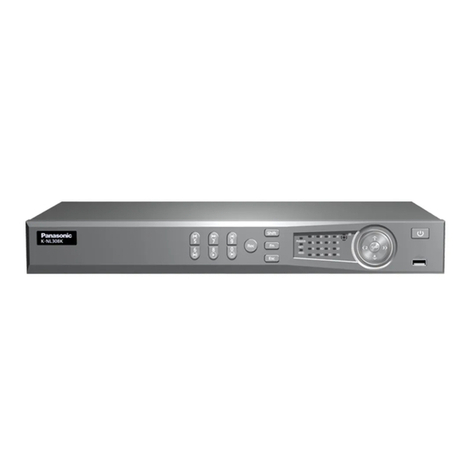
Panasonic
Panasonic k-nl304k user manual
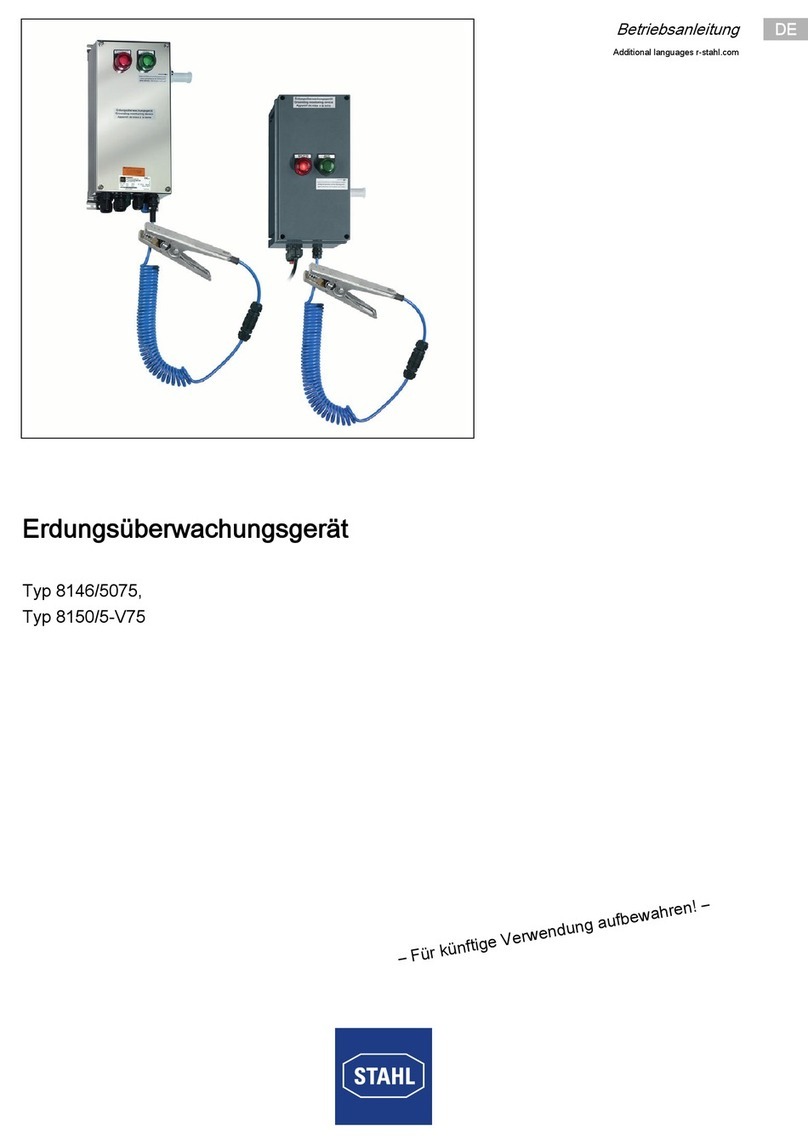
Stahl
Stahl Series 8146/5075 operating instructions
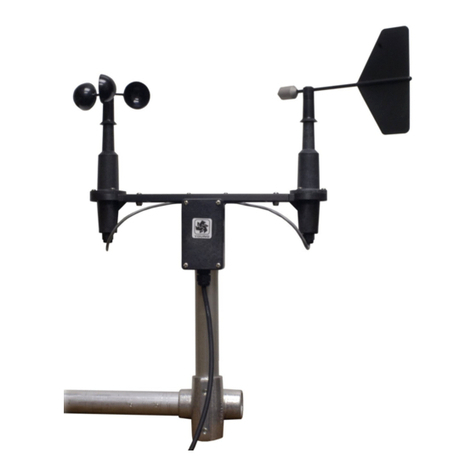
Campbell
Campbell 03002 product manual

Siemens
Siemens 7KT1 300 operating instructions
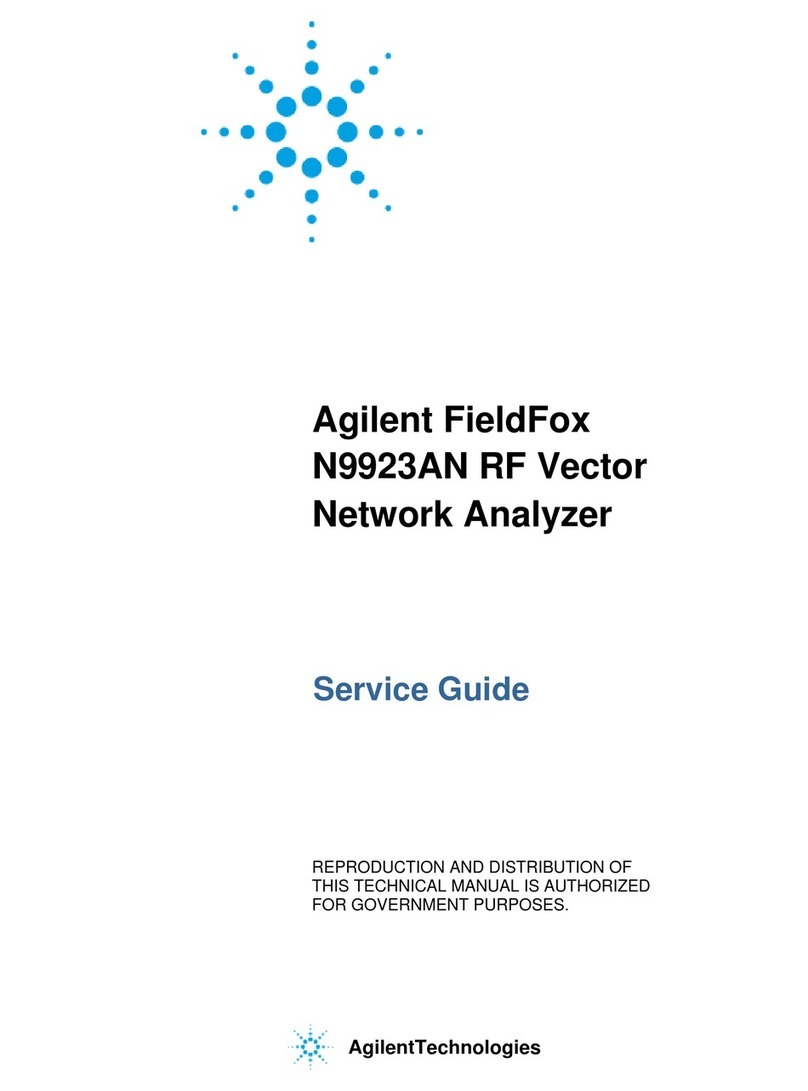
Agilent Technologies
Agilent Technologies FieldFox N9923AN Service manual

